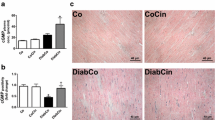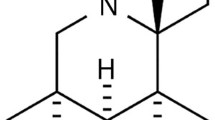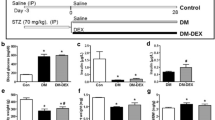Abstract
Objective: In diabetes, intracellular accumulation of sorbitol resulting from the high extracellular levels of glucose leads to depletion of intracellular compounds including taurine. This is associated with the development of late diabetic complications such as cardiomyopathy. The development of myocyte hypertrophy has been largely attributed to angiotensin II, whose growth properties are antagonized by taurine. However, the interaction between taurine, angiotensin II type2 receptor (AT2) and cardiomyopathy related to angiotensin II is still unknown. This study investigates the roles of taurine and AT2 in rats with streptozotocin (STZ)-induced diabetic cardiomyopathy.
Methods: Of 60 female 4-week-old Wistar rats, 8 were treated with common diet and the other 52 with high sugar/fat diet (during the whole experiment) to induce insulin resistance. At the 4th week, of the 52 rats, 7 treated with sodium citrate buffer (pH = 4.5) were grouped into control group1 (con1) and the other 45 were treated by intraperitoneal injection (I.P) with STZ to develop type 2 diabetes. At the 28th week, the maximal velocity decrease of pressure per second in left ventricle within the period of isovolumic relaxation (−dp/dtmax) was detected by a cannula through right carotid artery. After the cannula operation, of the 45 rats, all the living 24 with −dp/dtmax≤ 5250 mmHg/s, who had developed diabetic cardiomyopathy, were grouped as follows: 7 treated with double distilled H2O (I.P) were grouped into control group2 (con2). 8 treated with AT2 agonist (CGP42112A) (I.P) were grouped into experimental group1 (exp1). Another 9 treated with taurine (I.P) were grouped into experimental group2 (exp2). All injections lasted 4 weeks (Q.D) and the heart weight (HW) was recorded. To examine cardiomyocyte apoptosis index (CAI), mRNA and protein of AT2 and Bcl-2 in cardiomyocytes, methods of terminal-deoxynucltidyl transferase mediated nick end labeling (TUNEL), reversal transcription polymerase chain reaction (RT-PCR) and immunoblot (Western Blot) were used, respectively.
Results: Values of −dp/dtmax in exp1, exp2 or con2 were much less than those in con1, respectively (p < 0.01). CAI (= stained cell number/total cell number × 100%) and AT2 values both in mRNA and protein levels in con1 were less than those in the other three groups, respectively (p < 0.01). The three parameters above were more in exp1 but less in exp2 than those in con2, respectively (p < 0.01).The three parameters and HW in exp1 were much higher than those in exp2, respectively (p < 0.01). Changes of Bcl-2 were opposed to those of AT2.
Conclusions: A high expression of AT2 may accelerate the apoptosis of cardiomyocytes in diabetic rats and play a role in precipitating diabetic cardiomyopathy; taurine may protect diabetic rats from developing cardiomyopathy also by downregulating AT2 receptors.
Similar content being viewed by others
References
Rubler S, Dlugash J, Yuceoglu YZ, et al. New type of cardiomyopathy associated with diabetic glomerulosclerosis. Am J Cardiol 1972;30(6):595–602.
Ziegelhoffer A, Bundgaard H, Ravingerova T, et al. Diabetes and semi-starvation-induced changes in metabolism and regulation of Na, K-ATPase in rat heart. Diabetes Nutr Metab 2003;16(4):222–231.
Bidasee KR, Zhang Y, Shao CH, et al. Diabetes increases formation of advanced glycation end products on sarco (endo) plasmic Ca2+-ATPase. Diabetes 2004;53:463–473.
Shan YX, Yang TL, Mestril R, et al. Hsp10 and Hsp60 suppress ubiquitination of insulin-like growth factor-1 receptor and augment insulin-like growth factor-1 receptor signaling in cardiac muscle: implications on decreased myocardial protection in diabetic cardiomyopathy. J Biol Chem. 2003;278(46):45492–8.
Chen G, Lin LX, Zhuang WT, Yao J, et al. Expression of energy metabolism-related genes in myocardial tissues of rats with diabetic cardiomyopathy. Di Yi Jun Yi Da Xue Xue Bao. 2002 Nov;22(11):1009–1010.
Choi KM, Zhong Y, Hoit BD, et al. Defective intracellar Ca (2+) signaling contributes to cardiomyopathy in type 1 diabetic rats. Am J Physiol Heart Circ Physiol 2002;283(4):1398–408.
Hansen SH, The role of taurine in diabetes and the development of diabetic complications. Diabetes Metab Res Rev 2001;17(5):330–346.
Schaffer S, Solodushko V, Pastukh V, et al. Possible cause of taurine-deficient cardiomyopathy: potentiation of angiotensin II Action. J Cardiovascular Pharmacology 2003;41(5):751–9.
Thompson EW. Structural manifestations of diabetic cardiomyopathy in the rat and its reversal by insulin treatment. Am J Anat 1988;182(3):270–282.
Zhu XX, Zhou XP, Zhong XL, et al. Streptozocin induced cardiomyopathy in diabetic rats. Chin Med J (Engl) 1993;106(6):463–646.
Fein FS, Komstein LB, Strobecket JE, et al. Altered myocardial mechanics in diabetic rats. Circ Res 1980;47:922–933.
Ni LS, Zheng JC, Wang DW, et al. The primary study on the mRNA expression of angiotensin II type2 receptor and cytocrine in kidney of the diabetic rats. Zhongguo Zhong Zhong Xi Yi Jie He Za Zhi 2004;23(1):54–55.
Ichihara S, Senbonmatsu T, Edward P, et al. Angiotensin II type2 receptor is essential for left ventricular hypertrophy and cardiac fibrosis in chronic angiotensin II induced hypertension. Circulation 2001;104:346–351.
Matsumoto T, Ozono R, Oshima T, et al. Type 2 angiotensin II receptor is down regulated in cardiomyocytes of patients with heart failure. Cardiovasc Res 2000;46(1):73–81.
Horiuchi M, Akishita M, Victor J, et al. Recent progress in angiotensin II type2 receptor research in the cardiovascular system. Hypertension 1999;33:613–621.
Koyman I. The protective effect of taurine on the biomembrane against the damage produced by the oxygen radical. Adv ex Med Bio 1992;315:355.
Tokunaga H, Yoneda Y, Kuriyama K. Streptozotocin-induced elevation of pancreatic taurine contact and suppressive effect of taurine on insulin secretion. Eur J Pharmacol 1983;87(2-3):237–243.
N Lake. Loss of cardiac myofibrils: Mechanism of contractile deficits induced by taurine deficiency. Am J Physiol 1993;264(4 Pt 2):H1323–H1326.
S Punna, C Ballard, T Hamaguchi, et al. Effect of taurine and methionine on sarcoplasmic reticular Ca2+ transport and phospholipid methyltransferase activity. J Cardiovasc Pharmacol 1994;24(2):286–292.
F Franconi, MA Di Leo, F Bennardini, et al. Is taurine beneficial in reducing risk factors for diabetes mellitus? Neurochem Res 2004;29(1):143–150.
MS Suleiman, GC Rodrigo, RA Chapman. Interdependence of intracellular taurine andsodium in guinea pig heart. Cardiovasc Res 1992;26(9):897–905.
MS Suleiman. New concepts in the cardioprotective action of magnesium and taurine during the calcium paradox and ischaemia of the heart. Magnes Res 1994;7(3/4):295–312.
Author information
Authors and Affiliations
Corresponding author
Rights and permissions
About this article
Cite this article
Li, C., Cao, L., Zeng, Q. et al. Taurine May Prevent Diabetic Rats from Developing Cardiomyopathy also by Downregulating Angiotensin II Type2 Receptor Expression. Cardiovasc Drugs Ther 19, 105–112 (2005). https://doi.org/10.1007/s10557-005-0443-x
Issue Date:
DOI: https://doi.org/10.1007/s10557-005-0443-x




